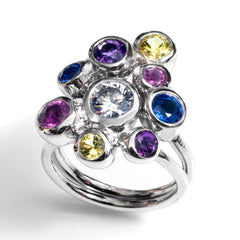Selecting Gemstones
Each stone has its own natural characteristics - we pride ourselves in the education we can provide and in finding top quality stones that respect your style and budget.
Gemstones are steeped in tradition and meaning, and available in every color of the rainbow. Integrating birthstones is a great way to personalize any jewelry design. Below is a list of traditional and alternative birthstones with helpful links to learn more!
Our Family Jewelry Collection features a great variety of jewelry pieces that are easily personalized for birthstone gifts!
|

Choosing An Engagement Stone
Visit Diamonds & Gemstones page to learn more about the traditional engagement stone, however there is no law that says an engagement ring can only be a diamond! Sapphires are a wonderful stone to use as they are both a durable material and available naturally in every color of the rainbow. The traditional blue sapphire is a wonderful "something blue" as well as being the traditional birthstone for the month of September.
Beyond aesthetics, history, and traditional meanings, one thing to take into consideration when choosing stones for a ring is the hardness. The Mohs Scale of Hardness helps to understand the durability of various materials compared to one another. Emeralds, opals, and pearls are wonderful in necklaces, earrings, and special occasion cocktail rings, but these materials are soft and prone to scratches and damage when worn as an everyday ring.
Lab-Created Gemstones
Lab-created gemstones are physically, chemically, and visually identical to their natural stone counterparts, only created within in the controlled environment of a laboratory. Ruby, sapphire, emerald, alexandrite, opal, and aquamarine, under the brand name Chatham, are created within a lab are very common and are a fraction of the cost of the natural stone version.
If you like the look of a diamond, moissanite is an excellent alternative and often referred to as a lab created diamond. It is a perfect molecular match to a diamond, but lab created which bypasses the sometimes-murky ethics of the diamond trade, and produces a pristine stone - bright white and blemish-free.
We always encourage clients to reuse stones from heirloom pieces or other jewelry. However, if you want to include stones but do not own any, we would be delighted to find the right ones for you within your budget. We do not keep large stones in inventory which allows us to get exactly what you want for your jewelry project.

Heirloom Stones
A great way to minimize your environmental impact is by re-purposing the metals and stones from heirloom jewelry. Sometimes people find that they have inherited jewelry that is just not their style, or have a pile of jewelry that is broken, missing its pair, or is simply not being worn and could go to better use. Rebecca has worked with many customers who are excited to give new life to something that is teeming with both material and sentimental value - but under-enjoyed within its original design. Now these freshly designed pieces can be cherished again for a lifetime to come!

